Spatio-Temporal Variation of the Urban Heat Island in Santiago, Chile during Summers 2005–2017
Abstract
1. Introduction
- Determination of the relationship between air temperature and satellite-derived LST.
- Analysis of historical UHI spatio-temporal temperature behavior.
2. Materials
2.1. Study Area
2.2. Satellite Data
2.3. Meteorological Data
3. Methods
3.1. Spatially Explicit Model of the Daily Air Temperature (Day/Night)
3.1.1. Linear Regression Model (LRM)
3.1.2. Spatially Explicit Regression Models (GWR)
3.1.3. Cokriging of Coefficients
3.2. Calculation and Analysis of UHIs
4. Results
4.1. Meteorological Database
4.2. Spatially Explicit Model of the Daily Air Temperature (Day/Night)
4.3. Calculation and Analysis of UHIs
5. Discussion
6. Conclusions
Author Contributions
Funding
Acknowledgments
Conflicts of Interest
References
- Schär, C.; Vidale, P.L.; Lüthi, D.; Frei, C.; Häberli, C.; Liniger, M.A.; Appenzeller, C. The role of increasing temperature variability in European summer heatwaves. Nature 2004, 427, 332–336. [Google Scholar] [CrossRef] [PubMed]
- Melorose, J.; Perroy, R.; Careas, S. World population prospects. U. N. 2015, 1, 587–592. [Google Scholar] [CrossRef]
- United Nations, Department of Economic and Social Affairs, Population Division. World Urbanization Prospects: The 2014 Revision, Highlights (ST/ESA/SER.A/352); United Nations: New York, NY, USA, 2014; ISBN 9789211515176. [Google Scholar]
- Romero, H.; Sarricolea, P. Patrones y Factores de Crecimiento Espacial de la Ciudad de Santiago de Chile y Sus Efectos en la Generación de Islas de Calor Urbanas de Superficie. In Proceedings of the Clima, Sociedad y Medio Ambiente, V Congreso de la Asociación Española de Climatología, Zaragoza, España, 18–21 September 2006; Serie A N°. pp. 827–837. [Google Scholar]
- Álvarez, C.J.D. Metabolismo urbano: Herramienta para la sustentabilidad de las ciudades. Interdisciplina 2014, 2, 51–70. [Google Scholar] [CrossRef]
- Kennedy, C.; Cuddihy, J.; Engel-Yan, J. The Changing Metabolism of Cities. J. Ind. Ecol. 2007, 11, 43–59. [Google Scholar] [CrossRef]
- Arnfield, A.J. Two decades of urban climate research: A review of turbulence, exchanges of energy and water, and the urban heat island. Int. J. Clim. 2003, 23, 1–26. [Google Scholar] [CrossRef]
- Abutaleb, K.; Ngie, A.; Darwish, A.; Ahmed, M.; Arafat, S. Assessment of Urban Heat Island Using Remotely Sensed Imagery over Greater Cairo, Egypt. Adv. Remote Sens. 2015, 4, 35–47. [Google Scholar] [CrossRef]
- Taha, H. Urban climates and heat islands: Albedo, evapotranspiration, and anthropogenic heat. Energy Build 1997, 25, 99–103. [Google Scholar] [CrossRef]
- Lehoczky, A.; Sobrino, J.A.; Skoković, D.; Aguilar, E. The Urban Heat Island Effect in the City of Valencia: A Case Study for Hot Summer Days. Urban Sci. 2017, 1, 9. [Google Scholar] [CrossRef]
- Deilami, K.; Kamruzzaman, M.; Liu, Y. Urban heat island effect: A systematic review of spatio-temporal factors, data, methods, and mitigation measures. Int. J. Appl. Earth Obs. Geoinf. 2018, 67, 30–42. [Google Scholar] [CrossRef]
- Rivera, E.; Antonio-Némiga, X.; Origel-Gutiérrez, G.; Sarricolea, P.; Adame-Martínez, S. Spatiotemporal analysis of the atmospheric and surface urban heat islands of the Metropolitan Area of Toluca, Mexico. Environ. Earth Sci. 2017, 76, 137. [Google Scholar] [CrossRef]
- Sobrino, J.A.; Oltra-Carrió, R.; Sòria, G.; Jiménez-Muñoz, J.C.; Franch, B.; Hidalgo, V.; Mattar, C.; Julien, Y.; Cuenca, J.; Romaguera, M.; et al. Evaluation of the surface urban heat island effect in the city of Madrid by thermal remote sensing. Int. J. Remote Sens. 2012, 34, 3177–3192. [Google Scholar] [CrossRef]
- De Ridder, K.; Maiheu, B.; Lauwaet, D.; Daglis, I.A.; Keramitsoglou, I.; Kourtidis, K.; Manunta, P.; Paganini, M. Urban Heat Island Intensification during Hot Spells—The Case of Paris during the Summer of 2003. Urban Sci. 2016, 1, 3. [Google Scholar] [CrossRef]
- Nichol, J.E. A GIS-based approach to microclimate monitoring in Singapore’s high-rise housing estates. Photogramm. Eng. Remote Sens. 1994, 60, 1225–1232. [Google Scholar]
- Weller, J.; Thornes, E.J. An investigation of winter nocturnal air and road surface temperature variation in the West Midlands, UK under different synoptic conditions. Meteorol. Appl. 2001, 8, 461–474. [Google Scholar] [CrossRef]
- Keeratikasikorn, C.; Bonafoni, S. Urban Heat Island Analysis over the Land Use Zoning Plan of Bangkok by Means of Landsat 8 Imagery. Remote Sens. 2018, 10, 440. [Google Scholar] [CrossRef]
- Guiling, W.; Weimei, J.; Ming, W.E.I. An Assessment of Urban Heat Island Effect using Remote Sensing Data. Mar. Sci. Bull. 2008, 10, 14–25. [Google Scholar]
- Sobrino, J.A.; Irakulis, I. A Methodology for Comparing the Surface Urban Heat Island in Selected Urban Agglomerations Around the World from Sentinel-3 SLSTR Data. Remote Sens. 2020, 12, 2052. [Google Scholar] [CrossRef]
- Weng, Q. Thermal infrared remote sensing for urban climate and environmental studies: Methods, applications, and trends. ISPRS J. Photogramm. Remote Sens. 2009, 64, 335–344. [Google Scholar] [CrossRef]
- Mirzaei, M.; Verrelst, J.; Arbabi, M.; Shaklabadi, Z.; Lotfizadeh, M. Urban Heat Island Monitoring and Impacts on Citizen’s General Health Status in Isfahan Metropolis: A Remote Sensing and Field Survey Approach. Remote Sens. 2020, 12, 1350. [Google Scholar] [CrossRef]
- Kato, S.; Yamaguchi, Y. Analysis of urban heat-island effect using ASTER and ETM+ Data: Separation of anthropogenic heat discharge and natural heat radiation from sensible heat flux. Remote Sens. Environ. 2005, 99, 44–54. [Google Scholar] [CrossRef]
- Voogt, J. How Researchers Measure Urban Heat Islands. Dep. Geogr. Univ. West. Ontanrio 2007, 34. Available online: https://19january2017snapshot.epa.gov/sites/production/files/2014-07/documents/epa_how_to_measure_a_uhi.pdf (accessed on 22 September 2020).
- Zhang, P.; Imhoff, M.L.; Wolfe, R.E.; Bounoua, L. Characterizing urban heat islands of global settlements using MODIS and nighttime lights products. Can. J. Remote Sens. 2010, 36, 185–196. [Google Scholar] [CrossRef]
- Espinoza, P.S.; Martín-Vide, J.; Sarricolea, P. El estudio de la Isla de Calor Urbana de Superficie del Área Metropolitana de Santiago de Chile con imágenes Terra-MODIS y Análisis de Componentes Principales. Rev. Geogr. Norte Gd. 2014, 57, 123–141. [Google Scholar] [CrossRef]
- Tomlinson, C.J.; Chapman, L.; Thornes, J.E.; Baker, C. Derivation of Birmingham’s summer surface urban heat island from MODIS satellite images. Int. J. Clim. 2010, 32, 214–224. [Google Scholar] [CrossRef]
- Wan, Z. Collection-6 MODIS Land Surface Temperature Products Users’ Guide. 2013. Available online: https://lpdaac.usgs.gov/documents/118/MOD11_User_Guide_V6.pdf (accessed on 20 March 2017).
- Rizwan, A.M.; Dennis, L.Y.; Liu, C. A review on the generation, determination and mitigation of Urban Heat Island. J. Environ. Sci. 2008, 20, 120–128. [Google Scholar] [CrossRef]
- Dirección Meteorológica de Chile (DMC). Temperaturas en Santiago Marcaron un Nuevo Récord Histórico; DMC: Santiago, Chile, 2016. [Google Scholar]
- Subdere. Gobierno Regional Metropolitano División Administrativa de Chile. Available online: http://www.subdere.gov.cl/divisi%C3%B3n-administrativa-de-chile/gobierno-regional-metropolitano-de-santiago (accessed on 24 June 2017).
- Bell, M.; O’Neill, M.S.; Ranjit, N.; Borja-Aburto, V.H.; Cifuentes, A.L.; Gouveia, N. Vulnerability to heat-related mortality in Latin America: A case-crossover study in São Paulo, Brazil, Santiago, Chile and Mexico City, Mexico. Int. J. Epidemiol. 2008, 37, 796–804. [Google Scholar] [CrossRef] [PubMed]
- Muggeo, V.M.R.; Hajat, S. Modelling the non-linear multiple-lag effects of ambient temperature on mortality in Santiago and Palermo: A constrained segmented distributed lag approach. Occup. Environ. Med. 2008, 66, 584–591. [Google Scholar] [CrossRef]
- Peña, M.A. Relationships between remotely sensed surface parameters associated with the urban heat sink formation in Santiago, Chile. Int. J. Remote Sens. 2008, 29, 4385–4404. [Google Scholar] [CrossRef]
- INE—Instituto Nacional de Estadísticas. Censo de Población y Vivienda 2017. Available online: http://resultados.censo2017.cl/ (accessed on 22 June 2017).
- Busetto, L.; Ranghetti, L. MODIStsp: An R package for automatic preprocessing of MODIS Land Products time series. Comput. Geosci. 2016, 97, 40–48. [Google Scholar] [CrossRef]
- Estevez, J.; Gavilán, P. Procedimientos de validación de datos de estaciones meteorológicas automáticas. aplicación a la red de información agroclimática de andalucía. Inst. Investig. Form. Agrar. Aliment. 2008, 1–12. Available online: https://www.slideshare.net/LUISAQUIJEDIAZ/validacion-datos-estacion-meteo (accessed on 22 September 2020).
- Hooker, J.; Duveiller, G.; Cescatti, A. A global dataset of air temperature derived from satellite remote sensing and weather stations. Sci. Data 2018, 5, 180246. [Google Scholar] [CrossRef] [PubMed]
- Gutiérrez-Puebla, J.; Daniel-Cardozo, O.; García-Palomares, J.C. Regresión Geográficamente Ponderada (GWR) y estimación de la demanda de las estaciones del Metro de Madrid. In Proceedings of the XV Congreso Nacional de Tecnología de la Información Geográfica, AGE-CSIC, Madrid, España, 19–21 September 2012. [Google Scholar]
- Brunsdon, C.; Fotheringham, S.; Charlton, M. Geographically Weighted Regression. J. R. Stat. Soc. Ser. D 1998, 47, 431–443. [Google Scholar] [CrossRef]
- Soto Estrada, E. Regresión ponderada geográficamente para el estudio de la temperatura superficial en Medellín, Colombia. Rev. AIDIS 2013, 6, 42–53. [Google Scholar]
- Karnieli, A.; Agam, N.; Pinker, R.T.; Anderson, M.C.; Imhoff, M.L.; Gutman, G.G.; Panov, N.; Goldberg, A. Use of NDVI and Land Surface Temperature for Drought Assessment: Merits and Limitations. J. Clim. 2010, 23, 618–633. [Google Scholar] [CrossRef]
- Fábián, Z. Method of the Geographically Weighted Regression and an Example for its Application. Reg. Stat. 2014, 4, 61–75. [Google Scholar] [CrossRef]
- USGS. Global 30 Arc-Second Elevation (GTOPO30); USGS: Reston, VA, USA, 1996. [Google Scholar] [CrossRef]
- Emery, X. Apuntes de Geoestadística; Universidad de Chile: Santiago, Chile, 2013. [Google Scholar]
- LeGates, D.R.; McCabe, G.J. Evaluating the use of “goodness-of-fit” Measures in hydrologic and hydroclimatic model validation. Water Resour. Res. 1999, 35, 233–241. [Google Scholar] [CrossRef]
- Meek, D.W.; Howell, T.A.; Phene, C.J. Concordance Correlation for Model Performance Assessment: An Example with Reference Evapotranspiration Observations. Agron. J. 2009, 101, 1012–1018. [Google Scholar] [CrossRef]
- LeGates, D.R.; McCabe, G.J. A refined index of model performance: A rejoinder. Int. J. Clim. 2012, 33, 1053–1056. [Google Scholar] [CrossRef]
- Narita, D.; Tol, R.; Anthoff, D. Damage costs of climate change through intensification of tropical cyclone activities: An application of FUND. Clim. Res. 2009, 39, 87–97. [Google Scholar] [CrossRef]
- Willmott, C.J.; Ackleson, S.G.; Davis, R.E.; Feddema, J.J.; Klink, K.; LeGates, D.R.; O’Donnell, J.; Rowe, C.M. Statistics for the evaluation and comparison of models. J. Geophys. Res. Space Phys. 1985, 90, 8995. [Google Scholar] [CrossRef]
- DeLeeuw, J.; Akaike, H. Information Theory and Extension of the Maximum Likelihood Principle. In Proceedings of the 2nd International Symposium on Information Theory, Budapest, Hungary, 2–8 September 1973; Petrov, B.N., Csaki, F., Eds.; Akademia Kiado: Budapest, Hungary, 1973; pp. 267–281. [Google Scholar]
- Burnham, K.P.; Anderson, D.R. Model Selection and Inference—A Practical Information-Theoretic Approach; Springer Science & Business Media: New York, NY, USA, 1998; ISBN 9781475729191. [Google Scholar]
- Smith, P.; Aravena, H.R. Factores explicativos de la distribución espacial de la temperatura del aire de verano en Santiago de Chile. Rev. Geogr. Norte Gd. 2016, 63, 45–62. [Google Scholar] [CrossRef]
- Pebesma, E.; Benedikt, G. Spatial and Spatio-Temporal Geostatistical Modelling, Prediction and Simulation. Available online: https://mran.microsoft.com/snapshot/2017-02-04/web/packages/gstat/index.html (accessed on 12 April 2017).
- Reyes-Paecke, S.; Aldunce, I.M.F. Distribución, superficie y accesibilidad de las áreas verdes en Santiago de Chile. EURE 2010, 36, 89–110. [Google Scholar] [CrossRef]
- Actualización Onemi: Cinco Incendios Forestales se Mantienen Activos en Cinco Regiones del País. Available online: https://www.emol.com/noticias/Nacional/2016/01/31/786188/Actualizacion-Onemi-Cinco-incendios-forestales-se-mantienen-activos-en-cinco-regiones-del-pais.html (accessed on 30 September 2017).
- CONAF. Análisis de la Afectación y Severidad de los Incendios Forestales Ocurridos en Enero y Febrero de 2017 Sobre los Usos de Suelo y los Ecosistemas Naturales Presentes Entre las Regiones de Coquimbo y la Araucanía de Chile; Informe Técnico; Corporación Nacional Forestal: Santiago, Chile, 2017; p. 51. [Google Scholar]
- Jenks, G.F. The Data Model Concept in Statistical Mapping. Int. Yearb. Cartogr. 1967, 7, 186–190. [Google Scholar]
- Romero, H.; Molina, M. Relación espacial entre tipos de usos y coberturas de suelos e islas de calor en santiago de chile. An. Soc. Chil. Cienc. Geogr. 2008, 1, 223–230. [Google Scholar]
- Morales, R.G.E. Contaminación Atmosférica Urbana: Episodios Críticos de Contaminación Ambiental en la Ciudad de Santiago; Editorial Universitaria: Santiago, Chile, 2006; ISBN 9561118351. [Google Scholar]
- Qiao, Z.; Wu, C.; Zhao, D.; Xu, X.; Yang, J.; Li, F.; Sun, Z.; Liu, L. Determining the Boundary and Probability of Surface Urban Heat Island Footprint Based on a Logistic Model. Remote Sens. 2019, 11, 1368. [Google Scholar] [CrossRef]
- Li, X.; Zhou, Y.; Asrar, G.R.; Imhoff, M.; Li, X. The surface urban heat island response to urban expansion: A panel analysis for the conterminous United States. Sci. Total. Environ. 2017, 605, 426–435. [Google Scholar] [CrossRef]
- Alcoforado, M.J.; Andrade, H. Global Warming and Urban Heat Island. In Urban Ecology; Marzluff, J., Shulenberger, E., Endlicher, W., Alberti, M., Bradley, G., Ryan, C., Zumbrunnen, C., Simon, U., Eds.; Spinger: Boston, MA, USA, 2008; pp. 249–262. ISBN 9780387734118. [Google Scholar]
- Estrada, F.; Botzen, W.J.W.; Tol, R.S.J. A global economic assessment of city policies to reduce climate change impacts. Nat. Clim. Chang. 2017, 7, 403–406. [Google Scholar] [CrossRef]
- Gallo, K.; Hale, R.; Tarpley, D.; Yu, Y. Evaluation of the Relationship between Air and Land Surface Temperature under Clear- and Cloudy-Sky Conditions. J. Appl. Meteorol. Clim. 2011, 50, 767–775. [Google Scholar] [CrossRef]
- Ministerio Medio Ambiente de Chile. Estrategia Climática de Largo Plazo 2050. Available online: https://cambioclimatico.mma.gob.cl/estrategia-climatica-de-largo-plazo-2050/descripcion-del-instrumento/ (accessed on 10 September 2020).
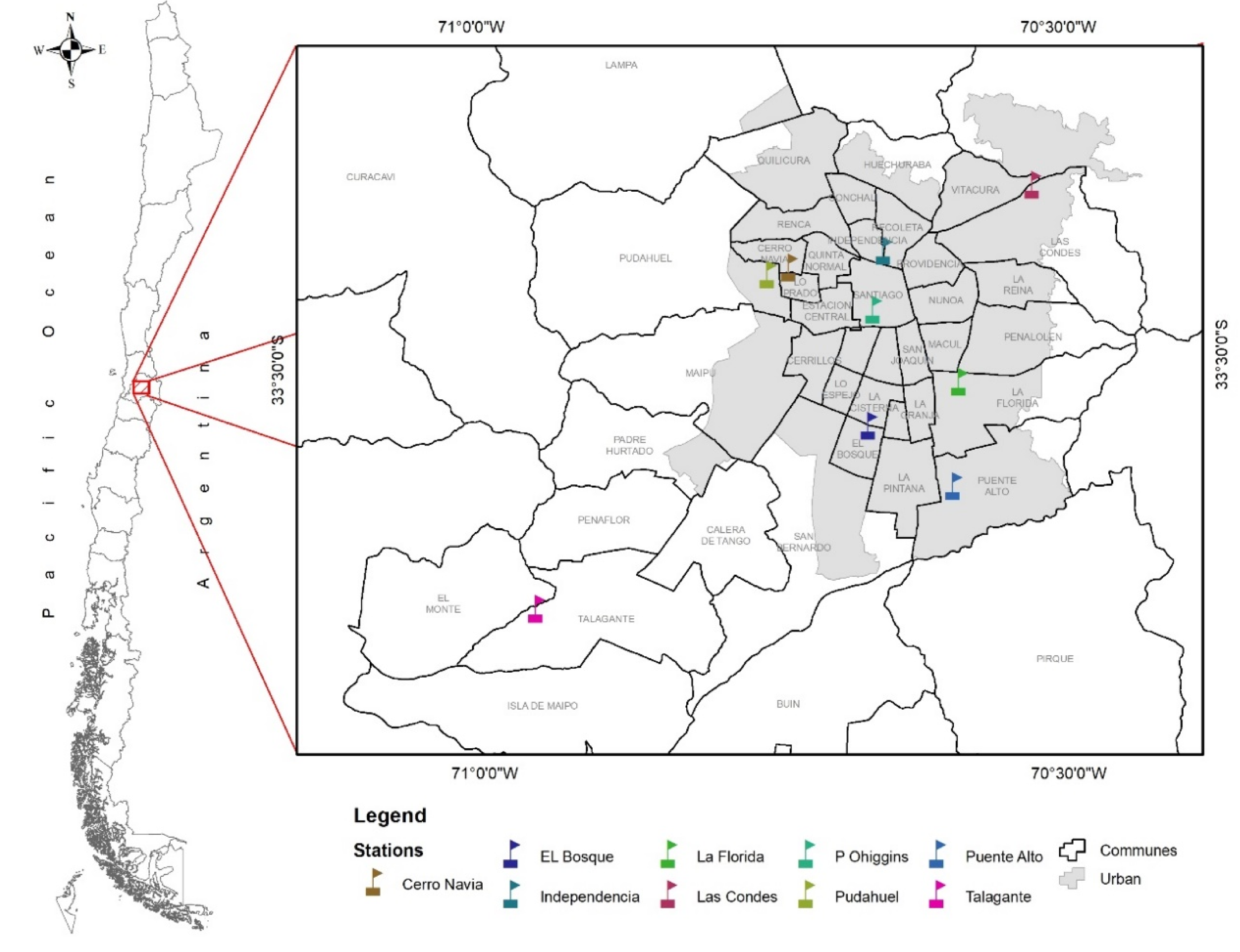
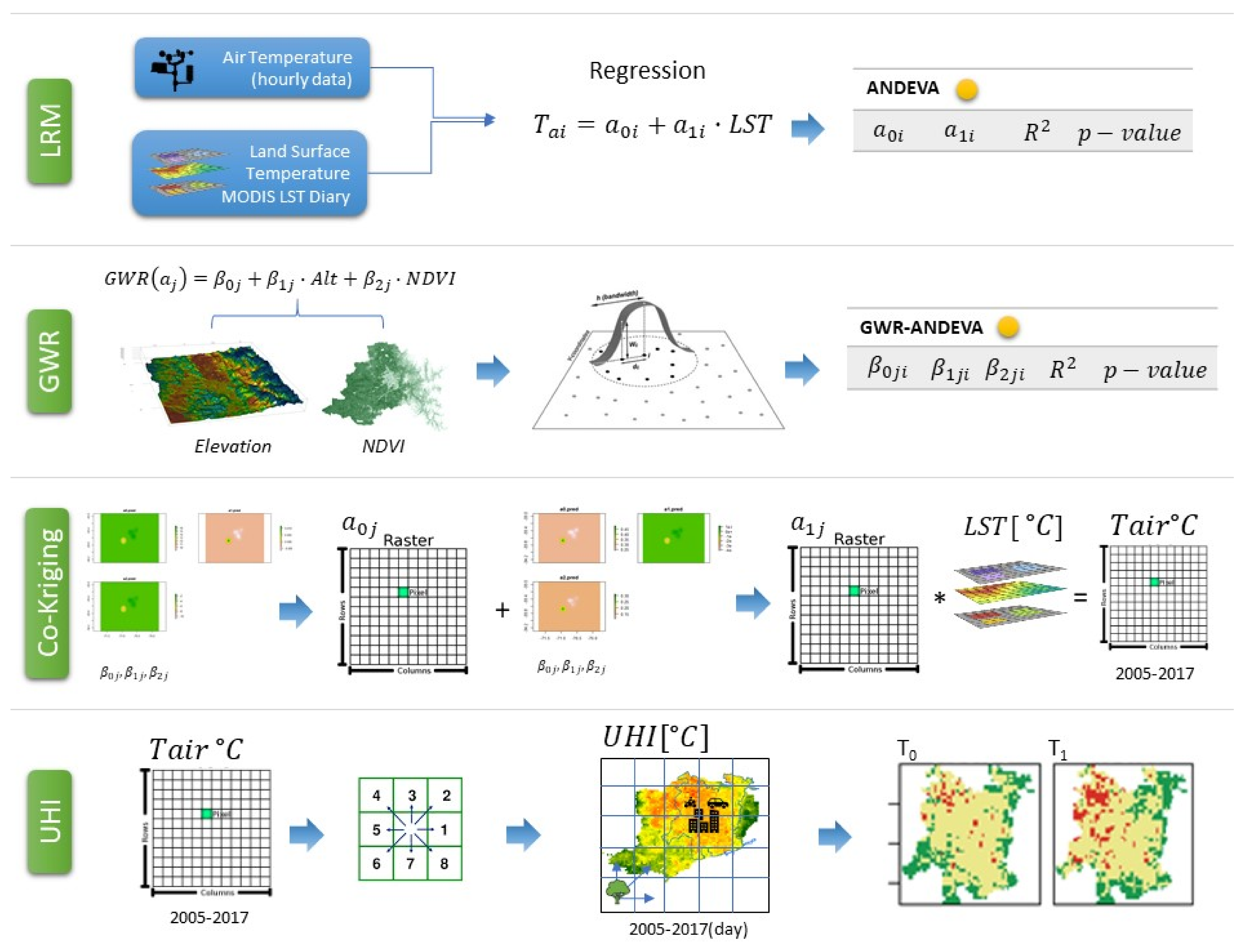
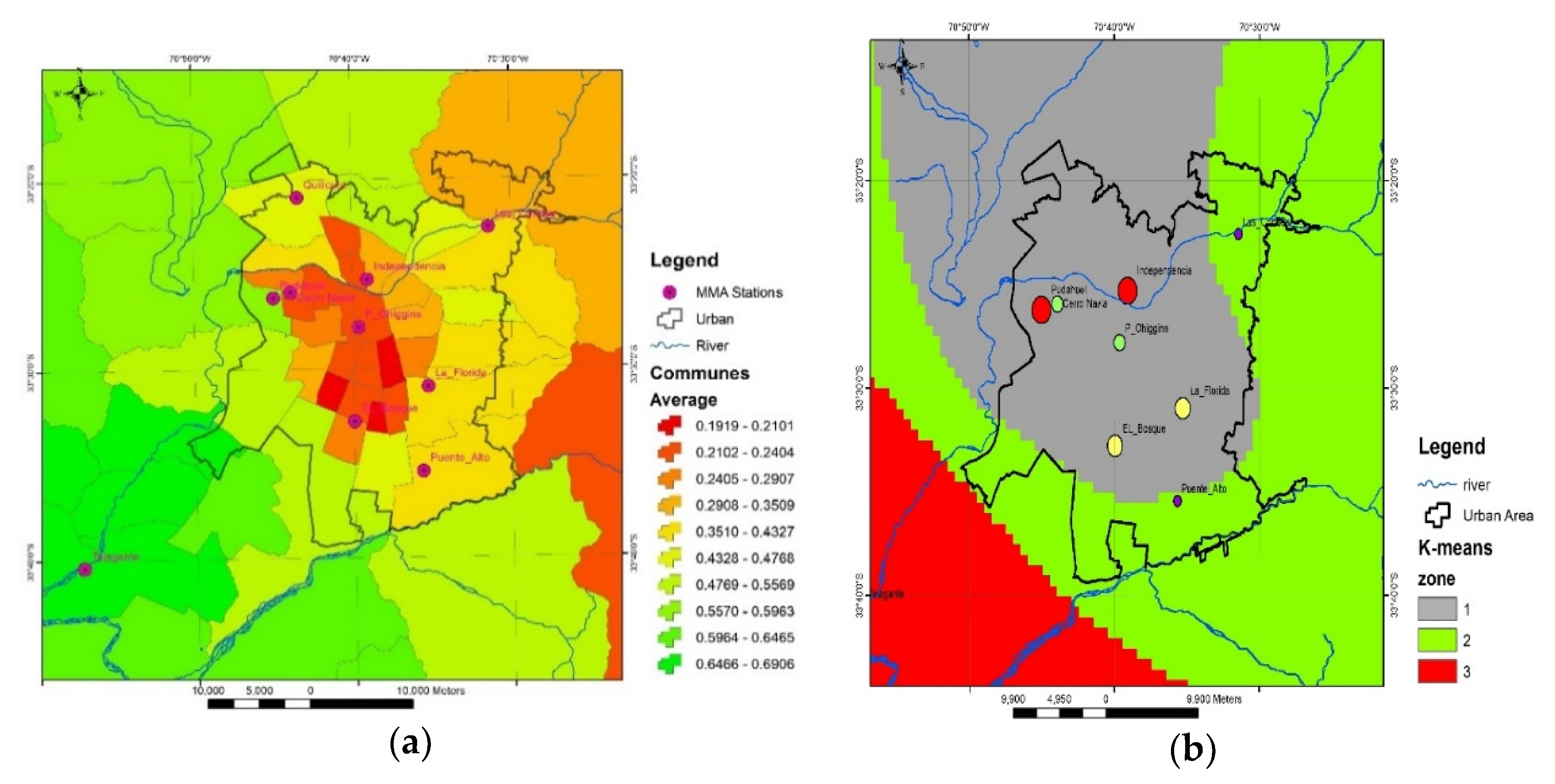
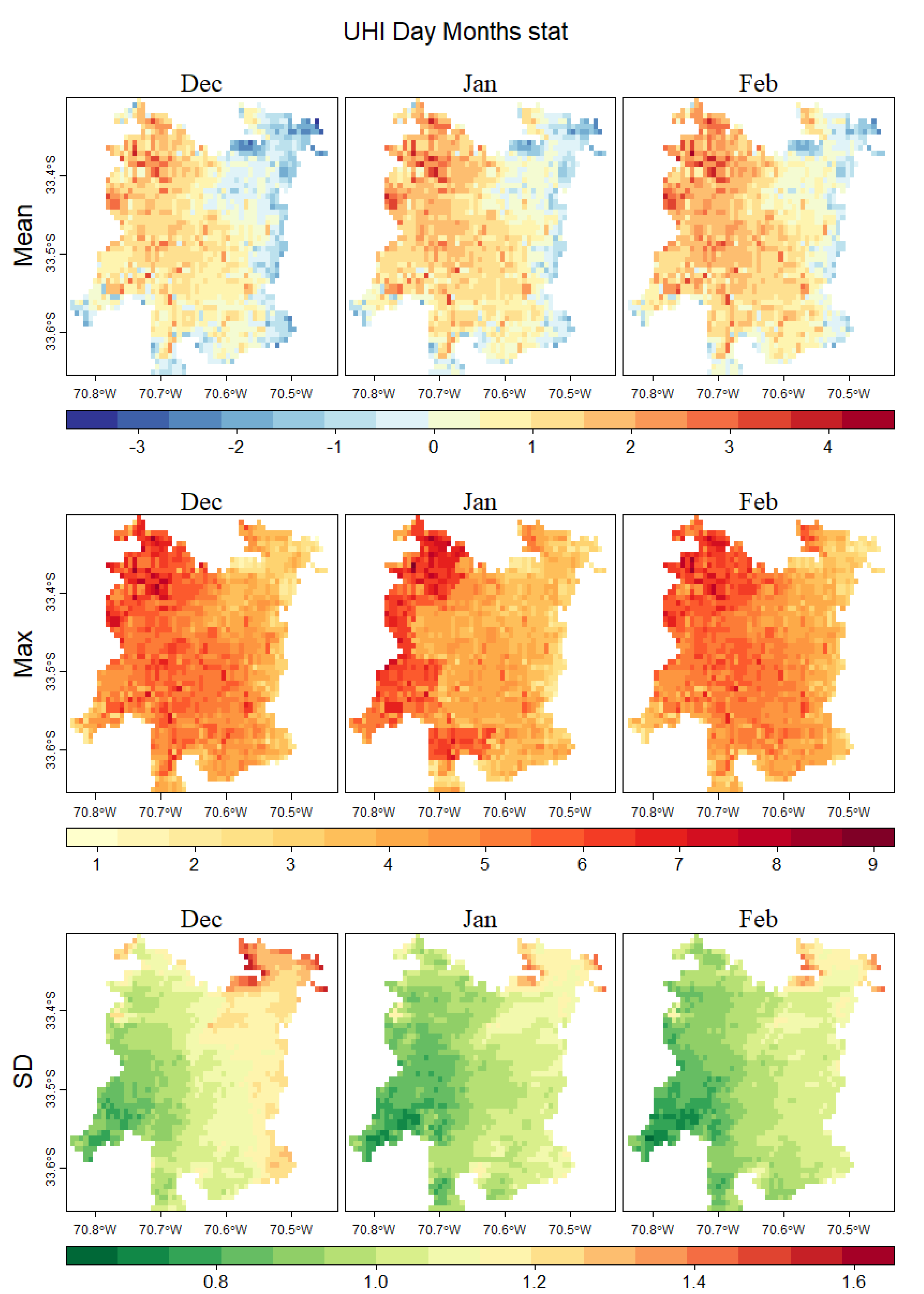


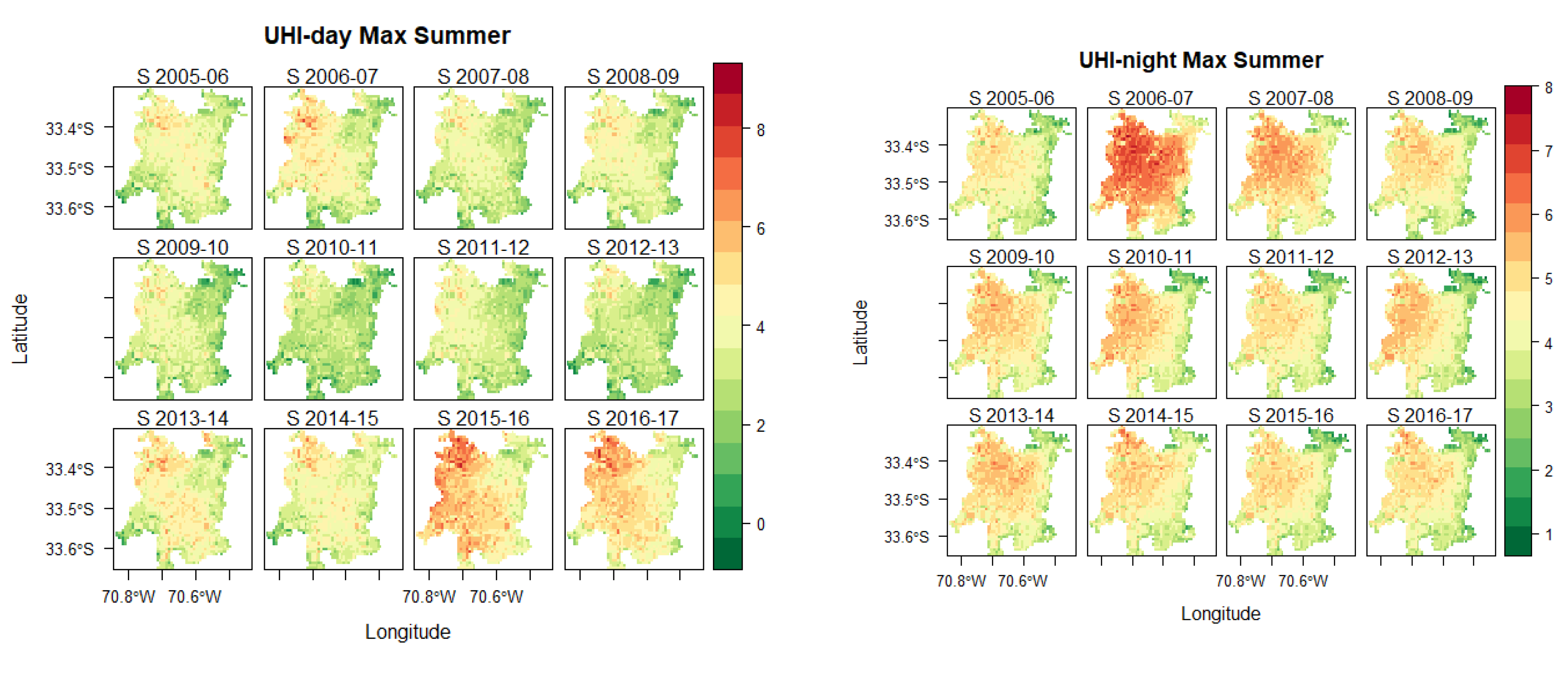
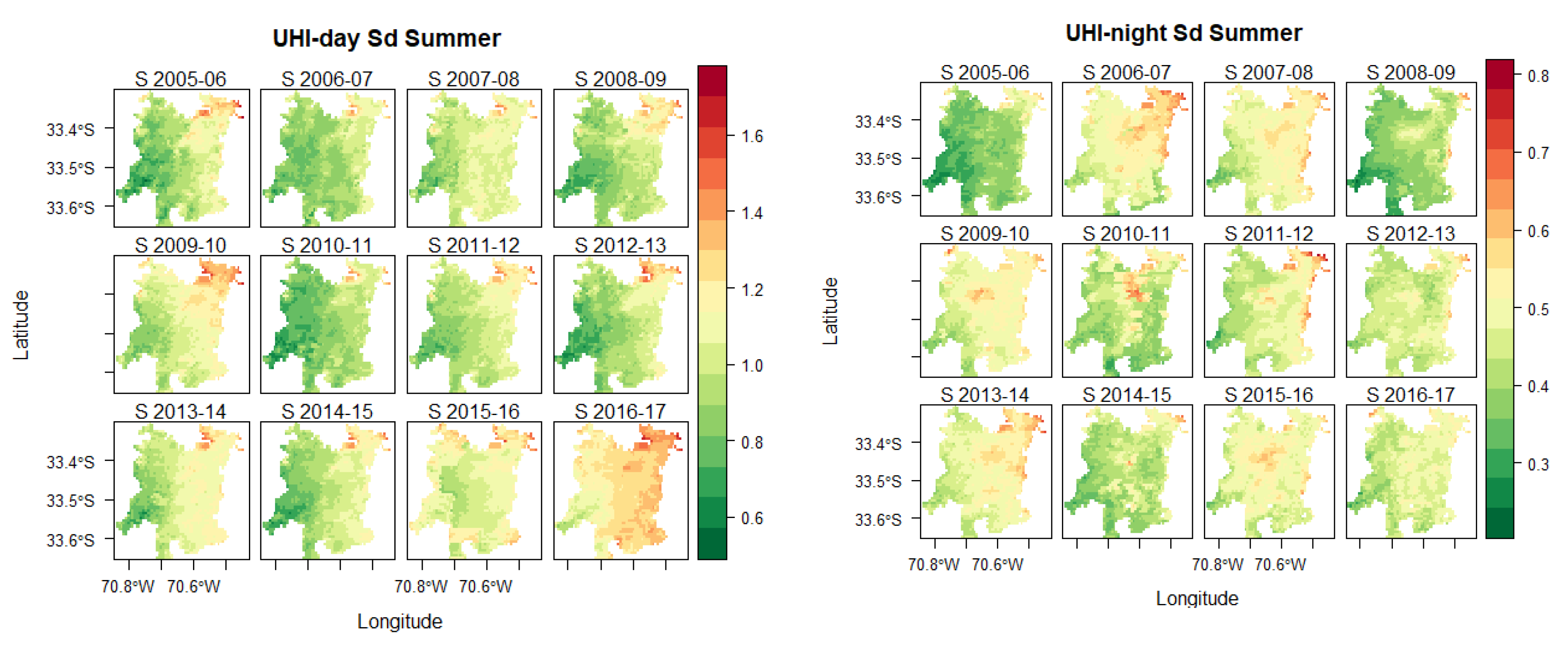

| Station Name | Eastern Coordinates (UTM 19S) | Northern Coordinates (UTM 19S) |
|---|---|---|
| Parque O’Higgins | 345673 | 6296019 |
| Independencia | 346488 | 6300681 |
| EL Bosque | 345313 | 6286825 |
| La Florida | 352504 | 6290304 |
| Las Condes | 358305 | 6305906 |
| Cerro Navia | 338984 | 6299360 |
| Pudahuel | 337311 | 6298809 |
| Puente Alto * | 352049 | 6282013 |
| Talagante * | 318945 | 6272298 |
| Description | Symbol | Equation | N° |
|---|---|---|---|
| Systematic error | BIAS | (5) | |
| Mean absolute error | MAE | (6) | |
| Root mean square error | RMSE | (7) | |
| Determination Coefficient | R2 | (8) | |
| Agreement Index | d | (9) | |
| Akaike information criterion | AIC | (10) |
| MMA * Station | Model | R2 | p-Value | ||
|---|---|---|---|---|---|
| Pudahuel | D & N | 14.3956 | 0.2745 | 0.6590 | <0.0001 |
| Independencia | D & N | 14.1418 | 0.3136 | 0.6860 | <0.0001 |
| La Florida | D & N | 12.7507 | 0.3359 | 0.7049 | <0.0001 |
| EL Bosque | D & N | 12.2912 | 0.3490 | 0.7427 | <0.0001 |
| Cerro Navia | D & N | 11.8035 | 0.3709 | 0.6434 | <0.0001 |
| Parque O’Higgins | D & N | 11.6696 | 0.3576 | 0.7483 | <0.0001 |
| Puente Alto | D & N | 11.4993 | 0.3235 | 0.6952 | <0.0001 |
| Las Condes | D & N | 10.7222 | 0.3989 | 0.7403 | <0.0001 |
| Talagante | D & N | 5.9368 | 0.5409 | 0.8531 | <0.0001 |
| Statistician | a0 | a1 |
|---|---|---|
| (%) | 11.76 ± 7.01% | |
| (%) | 0.36 ± 6.18% | |
| AIC | 27.7247 | −35.4228 |
| BIAS | −0.0737 | 0.0025 |
| R2 | 0.8795 | 0.8846 |
| Nash–Sutcliffe efficiency | 0.8082 | 0.8266 |
| RMSE | 0.8491 | 0.0252 |
| p-value | 0.0002 | 0.0002 |
© 2020 by the authors. Licensee MDPI, Basel, Switzerland. This article is an open access article distributed under the terms and conditions of the Creative Commons Attribution (CC BY) license (http://creativecommons.org/licenses/by/4.0/).
Share and Cite
Montaner-Fernández, D.; Morales-Salinas, L.; Rodriguez, J.S.; Cárdenas-Jirón, L.; Huete, A.; Fuentes-Jaque, G.; Pérez-Martínez, W.; Cabezas, J. Spatio-Temporal Variation of the Urban Heat Island in Santiago, Chile during Summers 2005–2017. Remote Sens. 2020, 12, 3345. https://doi.org/10.3390/rs12203345
Montaner-Fernández D, Morales-Salinas L, Rodriguez JS, Cárdenas-Jirón L, Huete A, Fuentes-Jaque G, Pérez-Martínez W, Cabezas J. Spatio-Temporal Variation of the Urban Heat Island in Santiago, Chile during Summers 2005–2017. Remote Sensing. 2020; 12(20):3345. https://doi.org/10.3390/rs12203345
Chicago/Turabian StyleMontaner-Fernández, Daniel, Luis Morales-Salinas, José Sobrino Rodriguez, Luz Cárdenas-Jirón, Alfredo Huete, Guillermo Fuentes-Jaque, Waldo Pérez-Martínez, and Julián Cabezas. 2020. "Spatio-Temporal Variation of the Urban Heat Island in Santiago, Chile during Summers 2005–2017" Remote Sensing 12, no. 20: 3345. https://doi.org/10.3390/rs12203345
APA StyleMontaner-Fernández, D., Morales-Salinas, L., Rodriguez, J. S., Cárdenas-Jirón, L., Huete, A., Fuentes-Jaque, G., Pérez-Martínez, W., & Cabezas, J. (2020). Spatio-Temporal Variation of the Urban Heat Island in Santiago, Chile during Summers 2005–2017. Remote Sensing, 12(20), 3345. https://doi.org/10.3390/rs12203345










